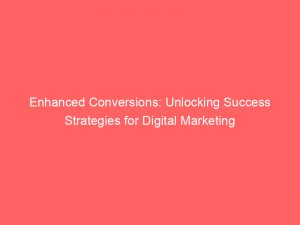- enhanced conversions
- What Are Enhanced Conversions?
- Capturing And Hashing Customer Data In Conversion Tracking Tags
- Matching Hashed Data With User Accounts On Google
- Setting Up Enhanced Conversions For Web
- Enhanced Conversions For Leads: Tracking Conversions From Form Submissions
- Storing Hashed Lead Information In CRM Database
- Upload Hashed Lead Information To Google When Becoming A Customer
- Setting Up Enhanced Conversions For Leads
- Benefits Of Enhanced Conversions: Easier Setup, Better Campaign Optimization, And Flexible Implementation
In today’s digital landscape, where every click and transaction holds immense value, businesses are constantly seeking ways to unlock the secrets of enhanced conversions. Picture this – the ability to capture and hash customer data, seamlessly matching it with user accounts, all to supercharge your marketing campaigns.
Enter Google Tag Manager and the Google tag, the dynamic duo that empowers businesses to effortlessly set up and optimize their web or lead conversions. With benefits ranging from easy setup and improved campaign optimization to unparalleled flexibility, the possibilities are boundless.
And fear not, for those hesitant to leave their comfort zone, the tried-and-tested GCLID-based method for tracking conversions still remains an option. Get ready to revolutionize your marketing game and dive into the world of enhancedconversions!
| Item | Details |
|---|---|
| Topic | Enhanced Conversions: Unlocking Success Strategies for Digital Marketing |
| Category | Ads |
| Key takeaway | In today's digital landscape, where every click and transaction holds immense value, businesses are constantly seeking ways to unlock the secrets of enhanced conversions. |
| Last updated | December 27, 2025 |
enhanced-conversions">enhanced conversions
Enhanced conversions refer to the process of capturing and hashing customer data in conversion tracking tags. This hashed data is then sent to Google to match with user accounts.
To set up enhanced conversions for web, you can use Google Tag Manager, the Google tag, or the Google Ads API. For tracking conversions specifically related to leads, enhanced conversions for leads can be implemented.
This involves sending lead information to Google in hashed form and storing it in the CRM database. The hashed lead information is then uploaded to Google when the lead becomes a customer.
There are several benefits of using enhanced conversions, including easier setup, better campaign optimization, and flexibility in implementation. It is worth noting that the existing GCLID-based upload method is still available for tracking conversions.
Key Points:
- Enhanced conversions involve capturing and hashing customer data in conversion tracking tags.
- Google Tag Manager, Google tag, and Google Ads API can be used to set up enhanced conversions for web.
- Enhanced conversions for leads involve sending hashed lead information to Google and storing it in the CRM database.
- The hashed lead information is uploaded to Google when the lead becomes a customer.
- Benefits of using enhanced conversions include easier setup, better campaign optimization, and flexibility in implementation.
- The existing GCLID-based upload method is still available for tracking conversions.
Sources
https://support.google.com/google-ads/answer/9888656?hl=en
https://support.google.com/google-ads/answer/12785474?hl=en
https://www.portent.com/blog/paid-media/understanding-enhanced-conversions-in-google-ads.htm
https://www.adaptworldwide.com/insights/2021/google-enhanced-conversions-what-you-need-to-know
Check this out:
💡 Pro Tips:
1. Use multiple conversion tracking tags: Instead of relying on just one conversion tracking tag, consider using multiple tags to capture different types of conversions. This can provide more detailed insights and allow for more targeted campaign optimization.
2. Utilize audience segmentation: Once you have captured customer data through conversion tracking tags, use this information to segment your audience. By targeting specific segments with tailored messaging and offers, you can further enhance your conversions.
3. Experiment with different attribution models: Enhanced conversions provide more data for attribution modeling. Take advantage of this by testing out different attribution models to understand how different touchpoints contribute to your conversions. This can help you allocate your resources more effectively.
4. Continuously optimize your conversion tracking: Don’t just set up enhanced conversions and forget about them. Regularly monitor and optimize your conversion tracking tags to ensure accurate data and maximize the benefits of enhanced conversions.
5. Utilize offline conversion tracking: If your business involves offline conversions, take advantage of the offline conversion tracking capabilities offered by Google. This allows you to track conversions that occur offline, such as in-store purchases or phone calls, and attribute them to your online advertising efforts.
What Are Enhanced Conversions?
Enhanced conversions are an advanced method of tracking and measuring customer interactions on a website. This technique involves capturing and hashing customer data in conversion tracking tags, allowing for more accurate and personalized analysis.
By using this approach, businesses can gain valuable insights into their customers’ behavior and optimize their digital marketing campaigns effectively.
Capturing And Hashing Customer Data In Conversion Tracking Tags
To harness the power of enhanced conversions, businesses must first capture and hash customer data in conversion tracking tags. These tags are embedded within the website’s code and collect information about user interactions, such as clicks, form submissions, or purchases.
The customer data collected is then transformed into a hashed format, which is a unique string of characters that cannot be reverse-engineered to retrieve the original data.
Matching Hashed Data With User Accounts On Google
The hashed customer data collected through conversion tracking tags is sent to Google to match with user accounts. This matching process connects the website interactions with the specific users logged into Google services, such as Gmail or YouTube.
By associating these interactions with specific user accounts, businesses can gain a deeper understanding of their target audience’s preferences, interests, and behaviors.
Setting Up Enhanced Conversions For Web
There are three primary methods to set up enhanced conversions for web:
- Google Tag Manager: Utilize Google Tag Manager, a user-friendly tool that allows businesses to easily manage and deploy conversion tracking tags on their website.
With Google Tag Manager, you can implement enhanced conversions without requiring any technical coding knowledge.
- Google Tag: Alternatively, businesses can directly implement enhanced conversions for web by adding the necessary conversion tracking tags manually.
This method is more suitable for those experienced in coding and website development.
- Google Ads API: For businesses with complex digital ecosystems, the Google Ads API provides a programmatic way to manage enhanced conversions.
This method allows for integration with existing systems and automation of the conversion tracking process.
Enhanced Conversions For Leads: Tracking Conversions From Form Submissions
Enhanced conversions for leads focus on tracking conversions that occur after a user fills in a form on the website. This is particularly useful for businesses that rely on form submissions for lead generation.
To enable enhanced conversions for leads:
Storing Hashed Lead Information In CRM Database
The hashed lead information collected through enhanced conversions is securely stored in the CRM (Customer Relationship Management) database. This database serves as a centralized location for businesses to manage and analyze customer data effectively.
By storing the hashed lead information, businesses can maintain data privacy while still benefitting from detailed insights and campaign optimization.
Upload Hashed Lead Information To Google When Becoming A Customer
When a lead eventually becomes a customer, their hashed lead information can be uploaded to Google. This step is crucial for businesses looking to leverage the full potential of enhanced conversions.
Uploading hashed lead information allows for more precise targeting, personalized ad campaigns, and improved ROI.
Setting Up Enhanced Conversions For Leads
Similar to enhanced conversions for web, there are multiple methods to set up enhanced conversions for leads:
Benefits Of Enhanced Conversions: Easier Setup, Better Campaign Optimization, And Flexible Implementation
Enhanced conversions offer several benefits that can greatly impact a business’s digital marketing strategies:
In conclusion, enhanced conversions provide a powerful tool for businesses to unlock success in their digital marketing efforts. By capturing and hashing customer data, matching it with user accounts, and utilizing platforms like Google Tag Manager, businesses can optimize their campaigns and improve their overall marketing strategy.
With the benefits of easier setup, better campaign optimization, and flexible implementation, enhanced conversions are a valuable asset for driving success in the digital world.











